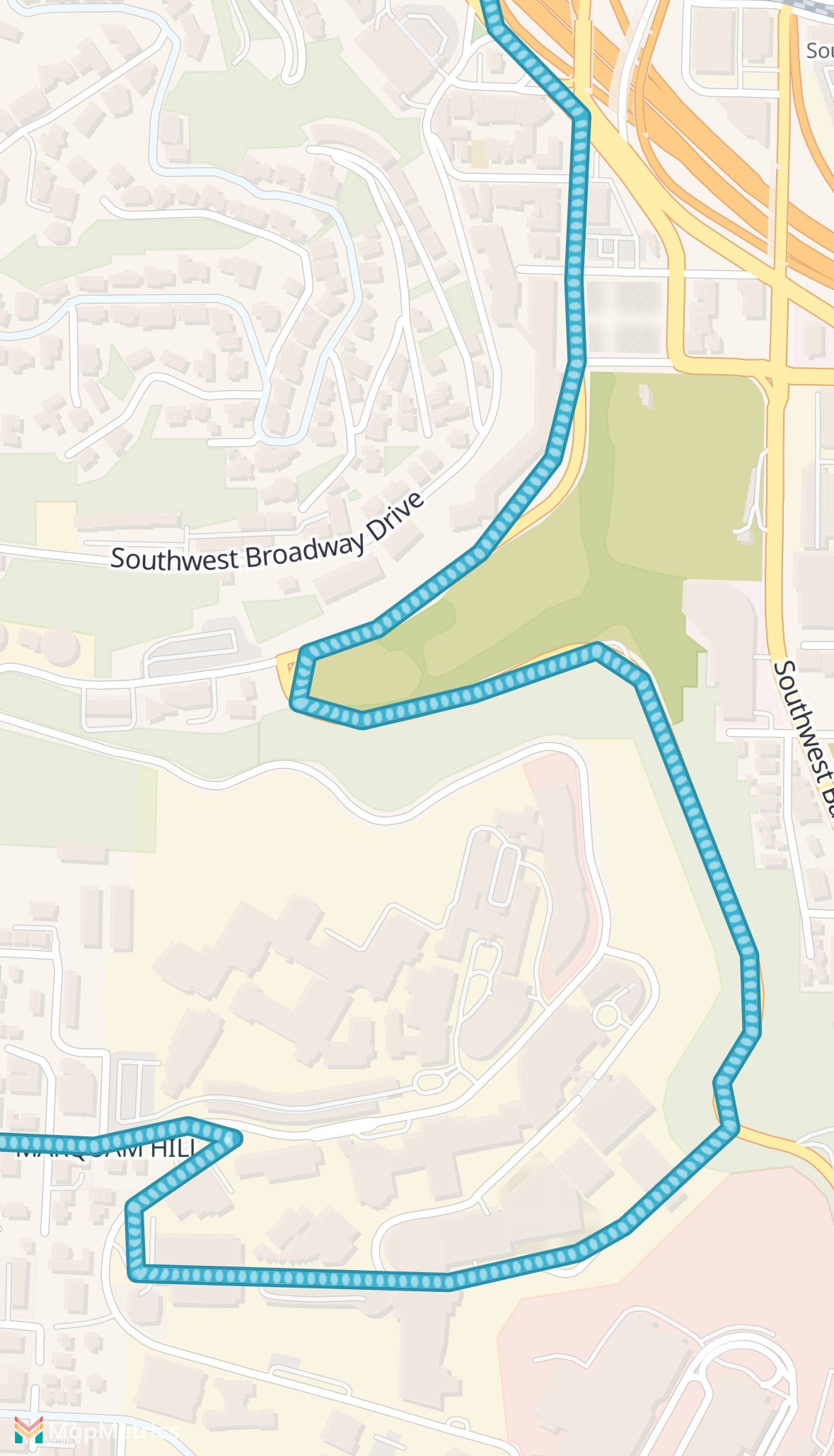Using GeoJSON with a line style layer
Adding an MLNLineStyleLayer to the map using a GeoJSON file.
Note: This example uses UIKit.
swift
class LineStyleLayerExample: UIViewController, MLNMapViewDelegate {
var mapView: MLNMapView!
override func viewDidLoad() {
super.viewDidLoad()
mapView = MLNMapView(frame: view.bounds, styleURL: VERSATILES_COLORFUL_STYLE)
mapView.autoresizingMask = [.flexibleWidth, .flexibleHeight]
mapView.setCenter(
CLLocationCoordinate2D(latitude: 45.5076, longitude: -122.6736),
zoomLevel: 11,
animated: false
)
view.addSubview(mapView)
mapView.delegate = self
}
// Wait until the map is loaded before adding to the map.
func mapView(_: MLNMapView, didFinishLoading _: MLNStyle) {
loadGeoJson()
}
func loadGeoJson() {
DispatchQueue.global().async {
// Get the path for example.geojson in the app’s bundle.
guard let jsonUrl = Bundle.main.url(forResource: "example", withExtension: "geojson") else {
preconditionFailure("Failed to load local GeoJSON file")
}
guard let jsonData = try? Data(contentsOf: jsonUrl) else {
preconditionFailure("Failed to parse GeoJSON file")
}
DispatchQueue.main.async {
self.drawPolyline(geoJson: jsonData)
}
}
}
func drawPolyline(geoJson: Data) {
// Add our GeoJSON data to the map as an MLNGeoJSONSource.
// We can then reference this data from an MLNStyleLayer.
// MLNMapView.style is optional, so you must guard against it not being set.
guard let style = mapView.style else { return }
guard let shapeFromGeoJSON = try? MLNShape(data: geoJson, encoding: String.Encoding.utf8.rawValue) else {
fatalError("Could not generate MLNShape")
}
let source = MLNShapeSource(identifier: "polyline", shape: shapeFromGeoJSON, options: nil)
style.addSource(source)
// Create new layer for the line.
let layer = MLNLineStyleLayer(identifier: "polyline", source: source)
// Set the line join and cap to a rounded end.
layer.lineJoin = NSExpression(forConstantValue: "round")
layer.lineCap = NSExpression(forConstantValue: "round")
// Set the line color to a constant blue color.
layer.lineColor = NSExpression(forConstantValue: UIColor(red: 59 / 255, green: 178 / 255, blue: 208 / 255, alpha: 1))
// Use `NSExpression` to smoothly adjust the line width from 2pt to 20pt between zoom levels 14 and 18. The `interpolationBase` parameter allows the values to interpolate along an exponential curve.
layer.lineWidth = NSExpression(forMLNInterpolating: NSExpression.zoomLevelVariable, curveType: MLNExpressionInterpolationMode.linear, parameters: nil, stops: NSExpression(forConstantValue: [14: 2, 18: 20]))
// We can also add a second layer that will draw a stroke around the original line.
let casingLayer = MLNLineStyleLayer(identifier: "polyline-case", source: source)
// Copy these attributes from the main line layer.
casingLayer.lineJoin = layer.lineJoin
casingLayer.lineCap = layer.lineCap
// Line gap width represents the space before the outline begins, so should match the main line’s line width exactly.
casingLayer.lineGapWidth = layer.lineWidth
// Stroke color slightly darker than the line color.
casingLayer.lineColor = NSExpression(forConstantValue: UIColor(red: 41 / 255, green: 145 / 255, blue: 171 / 255, alpha: 1))
// Use `NSExpression` to gradually increase the stroke width between zoom levels 14 and 18.
casingLayer.lineWidth = NSExpression(forMLNInterpolating: NSExpression.zoomLevelVariable, curveType: MLNExpressionInterpolationMode.linear, parameters: nil, stops: NSExpression(forConstantValue: [14: 1, 18: 4]))
// Just for fun, let’s add another copy of the line with a dash pattern.
let dashedLayer = MLNLineStyleLayer(identifier: "polyline-dash", source: source)
dashedLayer.lineJoin = layer.lineJoin
dashedLayer.lineCap = layer.lineCap
dashedLayer.lineColor = NSExpression(forConstantValue: UIColor.white)
dashedLayer.lineOpacity = NSExpression(forConstantValue: 0.5)
dashedLayer.lineWidth = layer.lineWidth
// Dash pattern in the format [dash, gap, dash, gap, ...]. You’ll want to adjust these values based on the line cap style.
dashedLayer.lineDashPattern = NSExpression(forConstantValue: [0, 1.5])
style.addLayer(layer)
style.addLayer(dashedLayer)
style.insertLayer(casingLayer, below: layer)
}
}